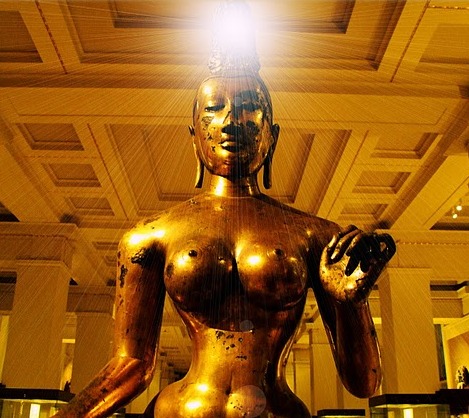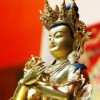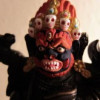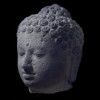“A History of the World in 100 Objects” was a joint project of BBC Radio 4 and the British Museum, comprising a 100-part radio series written and presented by British Museum director Neil MacGregor. In 15-minute presentations broadcast on weekdays on Radio 4, MacGregor used objects of ancient art, industry, technology and arms, all of which are in the British Museum’s collections, as an introduction to parts of human history. The series began in January 2010 and was broadcast over 20 weeks. Several of the objects had Buddhist significance, which we’re sharing here on the blog.
This bronze statue of Tara (object number 54) was made between eighth and ninth century CE in Sri Lanka. It stands in pride of place in the British Museum amongst an impressive collection of Buddhist art from Asia. The statue would have been used as a focus for meditation on the qualities Tara represents such as wisdom and compassion. When the sculpture was made, Sri Lanka had been predominantly Buddhist for about 1,000 years. It was then a hub for Indian Ocean trade and the sculpture may have been made by one of the Sri Lankan kings. In the Radio 4 programme Professor Richard Gombrich, British Indologist and scholar of Sanskrit, Pali, and Buddhist Studies says this of the sculpture:
“I am not a religious person so I just see it as a wonderfully beautiful, and indeed quite sensuous, figure of a woman, and you can also see it is a work of extraordinary technical perfection.”
According to the BBC website:
“She is both regal and human. Her narrow waist, rounded hips, full breasts, lips and large almond-shaped eyes all represent the Indian epitome of feminine beauty. Yet the magnificent image of Tara which stands proudly at the head of the main gallery for South Asia at the British Museum did not always enjoy such an impressive position. When first received into the Museum’s collection in 1830, she was kept from open display for fear her overtly erotic form may offend delicate contemporary sensibilities. However, in ninth century Sri Lanka, Tara’s curvaceous figure and full breasts would have had an entirely different association. Indeed, her very sensuality was precisely what would inspire awe and veneration.”
In the programme Neil MacGregor states:
“The statue of Tara is cast in one piece of solid bronze, that has been covered in gold. When new, she must have been dazzling when she was seen under the Sri Lankan sun. And even now, when her gilding is rather worn, and she stands in the cool light of Bloomsbury, she still has a compelling lustre. She is about three quarters life-size, and she stands, as she always would have, on a plinth, so that as you look up at her, she benignly gazes down at you. Her face tells you at once that she comes from south Asia. But that’s not the first thing that strikes visitors as they look at her. She’s got a quite impossible hour-glass figure, and her upper body is completely naked. Her full and perfectly rounded breasts float above a tiny wasp waist, while below, a flimsy sarong is draped in gleaming folds, which cling to and beguilingly reveal her shapely lower body. So you will hardly be surprised to learn that when Tara arrived at the British Museum, from Ceylon as it was then known, in the 1830s, she was seen as so dangerously erotic and voluptuous that she was at once put into the store-rooms, and kept there for 30 years, visible only to specialist scholars on request. But this statue was absolutely not made to titillate. She is a religious being, one of the spiritual protectors to whom the Buddhist faithful can turn in distress, and from a religious tradition that has no difficulty at all in happily combining divinity and sensuality. The statue of Tara takes us into a world where faith and bodily beauty converge, to move us beyond ourselves. It also tells us a great deal about the world of Sri Lanka and south Asia, 1,200 years ago…”
“…Her beauty and her serenity speak of her endless compassion. Her right hand, held down by her side, is not at rest, but in the position known as ‘varada mudra’, the gesture of granting a wish – a clear demonstration of her prime role as the generous helper of the faithful. Her gilded skin, and the jewels that once adorned her, make it clear that this statue of Tara can only have been commissioned by people in command of enormous wealth. It’s very rare for a statue of this scale to survive; indeed, we know of no other example of this size from medieval Sri Lanka. At this date most large bronze statues would be cast by pouring the metal around a hollow clay core. Tara by contrast is bronze through and through, so whoever made her must have had a great deal of bronze, rare skill and a lot of experience of this very challenging kind of work. Tara is not just beautiful; she is a remarkable technical achievement, and she must have been very, very expensive.”
Tara is no longer a focus of Buddhist practice in Sri Lanka, but is still the most popular female Buddha the cultural sphere of Tibetan Buddhism such as Tibet, China, Nepal and Bhutan. This is because Tara is associated with Great Way (Skt. Mahayana) and Diamond Way (Skt. Vajrayana) Buddhism. Theravada Buddhism (“The Teaching of the Elders”) is practised in Sri Lanka today, so this image of Tara offers incontrovertible evidence for the historical presence of Mahayana Buddhism in the island of Sri Lanka.
The statue was unearthed from a field where she was probably hidden (and forgotten) for the better part of 600 years. The arrival of Islam in Southern India and Sri Lanka in the thirteenth century may explain the reason for this, as its adherents considered Buddhism as idolatrous and polytheistic. As successive Muslim invasions swept across the Indian subcontinent from the twelfth century, Buddhism was utterly wiped out, its places of learning razed to the ground, its temples sacked, and its practitioners put to the sword. Islam’s prohibition of images representing human forms (as demonstrated by the Taliban’s recent destruction of the Bamyan Buddhas), combined with its suppression of female sexuality, may lead us to surmise what could have happened to this beautiful sculpture were it not protected and hidden.
Listen to the recording of the radio programme here.
Read the transcript here.
Other posts which may be of interest :
Tags: British Museum, Islam, Statues, Tara





 Follow
Follow